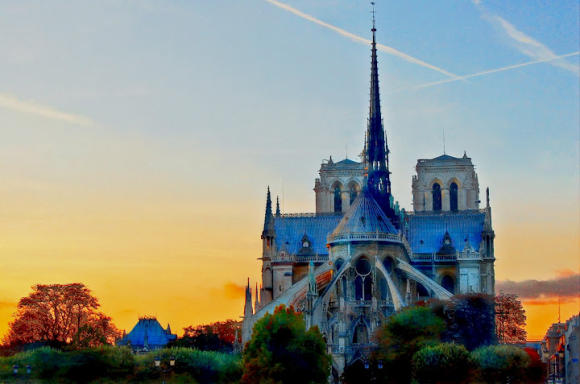
Notre-Dame de Paris viewed from the east (c) Joe Wilkins
April 16, 2019. In the wake of the fire that destroyed the roof and steeple of Notre-Dame to Paris, we republish this article paying homage to five glorious ladies of Gothic architecture, written in 2012 as Paris prepared the jubilee celebration honoring the 850th anniversary of the start of construction of the “new” cathedral of Paris.
As Paris prepares the jubilee celebration honoring the 850th anniversary of the beginning of construction of Notre-Dame Cathedral in 1163, France Revisited pays homage to that great Gothic monument at the center of the capital and to four other Notre-Dame Cathedrals within 100 miles of Paris. This article, of special interest to the historical and architectural traveler, is divided into two parts. Part I below concerns Notre-Dames of Paris, Laon and Chartres. Part II concerns Notre-Dames of Reims and Amiens and includes practical tips for visiting all five.
* * *
Think Notre-Dame and the great cathedral of Paris comes to mind. Notre-Dame (Our Lady) needs no last name; it refers first and foremost to the Gothic monument at the heart of the world’s most visited city.
Cathédrale Notre-Dame de Paris, to use its full name, is just one the great dames of Gothic architecture in northern France, the region at the hub of European religious architectural evolution in the 12th and 13th centuries and further restyling in the 14th and 15th centuries. Within a hundred miles of the French capital, four other Notre-Dame Cathedrals, each remarkable in its own way and each easily reached by train, offer the artful traveler their treasures of stone, sculpture and stained glass: Notre-Dame de Chartres, Notre-Dame de Laon, Notre-Dame de Reims and Notre-Dame d’Amiens.
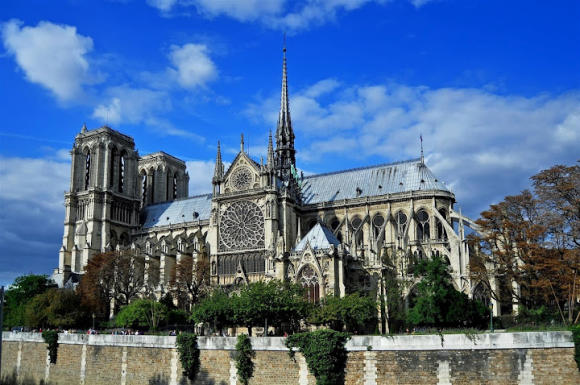
Properties of the State, these monuments are now the heritage of secular France as much as they are of Catholic France. Indeed, the great benefit of France’s devotion to maintaining and restoring them is that we, as visitors, have access to their technological and artistic magnificence and their craftsmanship without being asked to accept the doctrine and the politics that gave rise to their construction. One can naturally pray, reflect and/or confess there, but while these cathedrals continue to function as Catholic prayer houses, they do not require practice or belief in order to be appreciated for they also function is historical monuments—and not solely of French history, but of European history and world history as well.
The five Roman Catholic cathedrals described here are among the magnificent mammoths of French Gothic architecture. “French” Gothic is actually somewhat redundant for these structures begun between 1163 and 1120 since France’s role in developing techniques to build higher and wider structures and then to embellish them was so prominent that what we now call Gothic architecture was long referred to as “French style” or “the French art.”
Notre-Dame de Paris
The term Gothic was invented by culture mavens of the 16th century, dominated by Italian influences, because they saw the prior generation of churches as passé, lacking harmony and refinement, barbaric like the Goths of the Dark Ages. But try convincing the 13-14 million people that visit Notre-Dame de Paris each year that they’ve come to see something crass.
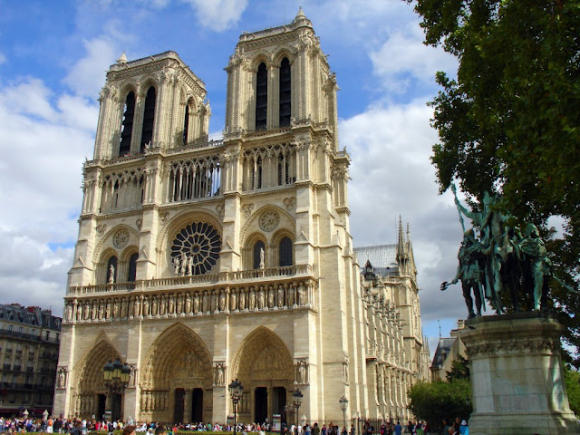
In 1160 Bishop Maurice de Sully of Paris decided that his city’s cathedral—at the time a hodgepodge of older structures built over successive foundations going back to Roman times—needed to enter the modern era. In 1163 the foundation stone of the new cathedral was laid in the presence of Pope Alexander III. The 850th anniversary of that event is being celebrated at Notre-Dame from Dec. 12, 2012 to Dec. 11, 2013, with some events beyond that date.
The anniversary has been the occasion to the replace tired old bells for the towers, design of new interior lighting, restore the organ, and create a new museography in the treasury. Conferences, concerts and other religious celebrations honoring the jubilee will take place throughout the year.
Though the footprint of the Notre-Dames was set in place when construction was launched, evolving techniques and styles would lead to modifications of plans over the decades, even centuries, that it took to complete the project. The central potion and towers of Notre-Dame de Paris took about 77 years to complete, the great rose windows another 20 years, and the light-infused chapels surrounding the choir another 70.
Gothic architecture began with decades in structural development of rib vaults by trial and error, so there is no single inventor of this type of architecture. Glimpses of the evolution toward the rib vault had come from various horizons, including from Moorish and Arab arches. But Saint Denis Basilica, just north of Paris, set the tone for the next three centuries of religious architecture in France (and well beyond) when in 1144 Abbot Segur, the man who gets the most credit, launched the reconstruction of the abbey church that was then affirming its status as the final resting place of the kings of France.
The main features of Gothic architecture such as the ribbed vault, the pointed arch, lancet windows, flying buttresses, even its gargoyles, were solutions to technical problems rather than decorative tastes. Previous techniques (Romanesque vaulting and buttressing) had reached its limits in height and width without the structure collapsing from its own weight. The solution was a new kind of vault able to bear the weight though relatively narrow pillars, with the outward thrust supposed by other arches and eventually supported by flying buttresses. Height and width increased while the most remarkable feature of these new structures was that walls now relieved of the role of bearing the full weight of the structure’s upward reach could now be opened to allow in light through fanciful windows.
While the craft of making colored or semi-transparent glass and joining them together with lead strips existed before the Gothic period, the accomplishment of structural techniques allowing for large opening (lancet windows, rose windows and assorted tracery) led to an explosion of stained-glass making, allowing for a craft to develop into an art.

Using metal oxides, minerals or plants, stained glass makers developed reds, greens, blues and yellows that not only flooded these structures with light but allowed the church to illustrate scenes from the Bible, to speak of the lives of saints, and to represent local life, including that of noble donors and trade guilds that helped finance construction. At a time when the majority of the population was illiterate, being able to present stories in glass and in stone was an educational tool as well as a treat to the eye and a glorification of the subject.
Notre-Dame de Paris represents a feat of technical and artistic prowess for the time. Higher and wider cathedrals exist. Stunning windows can also be seen elsewhere. Yet even first-time 21st-century visitors to Notre-Dame, now accustomed to light-infused interiors, emit oohs and ahs of appreciation when standing with a view of the long, high nave. Imagine then how a visitor entering in the early 1300s, when the cathedral was nearing completion, must have felt. The scene from the Wizard of Oz in which Dorothy and her three traveling companions first enter the realm of the great wizard himself comes to mind.
Visitors today can take a tour or borrow an audio-guide or find an app to better understand the main features of Notre-Dame’s windows, sculptures, paintings, architecture and history. Or you can follow in-depth guidebooks to learn the vocabulary of Notre-Dame: ambulatory, apse, baldachin, bay, chancel, chevet, clerestory, façade, frieze, gargoyles, keystone, lancet windows, narthex, nave, portal, portico, radiating chapel, rose window, stained glass, transept, triforium, vaulting, etc..
Of course, not everyone is interested in all of those details. Still, the impression, the eye appeal, remains and may be sufficient to feel that one has discovered something special in seeing Our Lady of Paris. Even more special, it’s worth noting that Paris is graced with two extraordinary monuments representing major advancements in the evolution of construction over the past 900 years: Sully’s cathedral and Eiffel’s tower. Some may even see in the Eiffel Tower an echo of Notre-Dame’s spire, a 19th-century addition to the cathedral
The height and fame of the Eiffel Tower tends to make it the elevation of choice for visitors who want to see over the rooftops of Paris, but the Quasimodo view from atop Notre-Dame, 402 steps up (and a painful 1½-2½-hour wait in line at most times of year), is actually the city’s most telling view since the cathedral stands on an island at the geographical and historic center of the city.
Notre-Dame de Laon
Laon’s Notre-Dame, 85 miles northeast of Paris, is a luminous cathedral that dominates the surrounding town and countryside from atop the last outlier plateau of the northern edge of the Paris region. This is another first-generation or primitive Gothic structure, begun at about the same time as the cathedral of Paris. Few of the millions of visitors to Paris’s Notre-Dame come this way, primarily because from Paris Laon isn’t on the direct route to any major city or region. It’s well worth the detour and is gratifyingly off the beaten track.
Other medieval churches and cathedrals rightfully boast about their stained glass windows, but on a sunny day the clear windows in the lantern tower of Notre-Dame de Laon allows the naked stone inside to bathe in a seductive, uniform light.
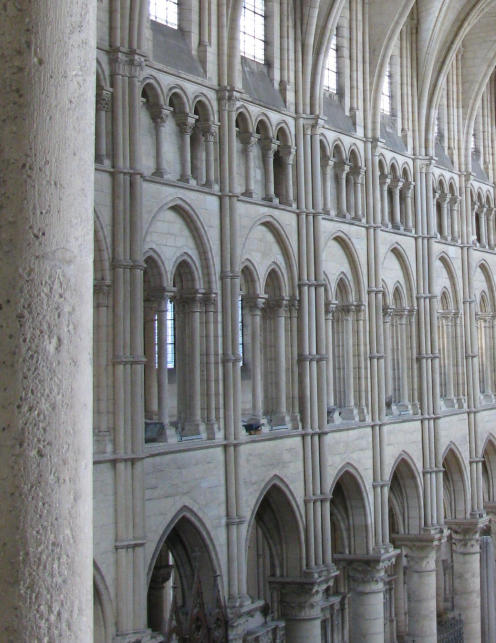
While Laon can’t pride itself on its colored glass, it’s got gargoyles galore. And what would Gothic cathedrals be without their gargoyles? The short answer: infiltrated by water. Indeed, gargoyles, from the French word for gurgle, are firstly water spouts, designed to direct water away from the building. Their decorative aspect is secondary.
We generally think of gargoyles as representing devilish figures warding off evil along with rainwater. Yet gargoyles and other carved figures on the sides and tops of cathedrals aren’t all grotesques or chimeras. Along with the fabulous bestiary of water spouts on its outer walls, Laon has the particularity of presenting sculptures of oxen near the top of its towers, placed here in homage to their role in hauling stones to create the edifice.
Medieval architects, the masons, the craftsman, and the general population clearly had a different sense of time in launching such a massive project. In fact, the towers of many medieval cathedrals were never completed. Two of the seven towers originally planned for Laon were never built.
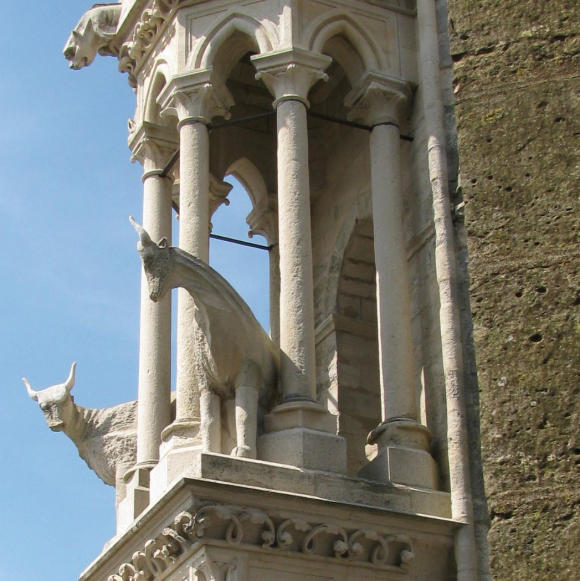
Guided tours take visitors up to the second-floor walkabout or tribune, giving a rare plunging view from inside a Gothic cathedral as well as the treat of seeing up close a collection of dismantled old gargoyles and weathered original sculptures—they truly are magnificent sight, a kind of medieval-cum-contemporary art that may even be more dramatic and telling now than when first created. Refashioned copies of these now adorn the cathedral outside.
From the second floor, the tour goes up to the towers, near the oxen, for a wonderful view of the cathedral’s heights, the old town below, and the surrounding countryside. Notre-Dame de Laon isn’t the highest of these cathedrals as measured from its base, but built on a plateau and has a wide view over the region. This Notre-Dame fully deserves its place among the great dames of France.
(More views of Notre-Dame de Laon can be found in the photo reportage here.)
Notre-Dame de Chartres
The French sculptor Auguste Rodin, a forward-looking artist who was never afraid to look back, called the Cathedral of Chartres “the Acropolis of France” for the way that it brought together the best that France had to offer in a building: rock for the walls, arches and sculptures; wood for the roof timbers; plants and minerals to color the stained glass, and the sun to stream through them.

Well, maybe not always sun here in northern France, but Chartres, 56 miles southwest of Paris, nevertheless stands out in any weather or season as one of the foremost jewels of Gothic art and architecture.
As all of these Notre-Dames, the cathedral seen today at Chartres stands on the remnants of a succession of religious buildings on its site. War, fire or a need to expand led to the construction of successive churches here. Some claim, without proof, that this site was already sacred to the Druids who led religious affairs for the Celtic tribe defeated during the Roman conquest of 52 BC. Pourquoi pas? The crypt of a 9th-century church that was destroyed by fire still lies under the current cathedral. Another fire in 1194 destroyed much of the 11th and 12th-century Romanesque basilica that replaced, though the western façade and its tower bases remain.
As for most of the rest, that 1194 fire coincided with a period of near mastery of Gothic architecture, and the builders, craftsman and artists involved with the relatively quick construction of Chartres took full advantage of that know-how. The cathedral was consecrated in 1260.
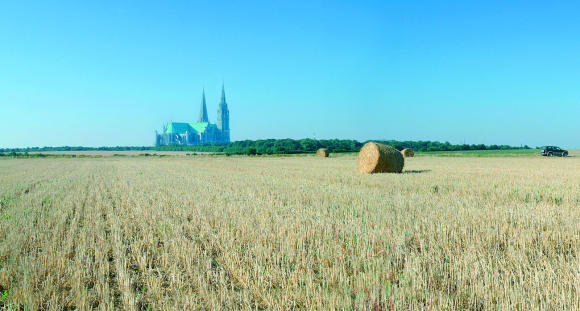
The silhouette of Notre-Dame de Chartres’ two uneven towers can be seen from miles away as you arrive by train or by car through the region’s wheat plains.
More than Notre-Dame de Paris, Chartres, a second-generation or classical Gothic construction, reveals the technological, artisanal and artistic prowess of the 13th century in part because it is exceptionally rich in stained glass from that time. That’s why so many travelers choose Chartres for their primary cathedral excursion from Paris. Though Amiens is a more entertaining town, Laon is more of an off-the-beaten-track discovery, and Reims offers more history plus champagne, Chartres Cathedral is rightfully deserving of its status as the ideal monument, for those willing to spend the time, for an in-depth understanding of Gothic art, craft and architecture.
Though most people now come to Chartres for the splendor of the cathedral rather than for prayer, it’s not uncommon to see some visitors following the 13th-century labyrinth inlaid on the floor beyond the entrance. Walked (or shuffled along on one’s knees) at a steady rhythm in silent prayer or meditation, movement along the labyrinth can symbolize a pilgrimage to Jerusalem and the route to Christian redemption. It can also be seen simply as pleasant decoration. (An American company builds copies of the labyrinth for churches in the United States—choose your pavers.)
There are 4000 statues on the entranceways yet the cathedral is most celebrated for its stained glass windows, 28,000 square feet (or just over three-fifths of an acres) of them, mostly dating from 12th and 13th centuries. At a time when the majority of the population was illiterate, these representations in glass and in stone—of scenes from the Bible, of the lives of saints, of local life, and of noble donors and guilds that helped finance construction—were not simply decorative; they were an educational tool and a glorification of their subject.
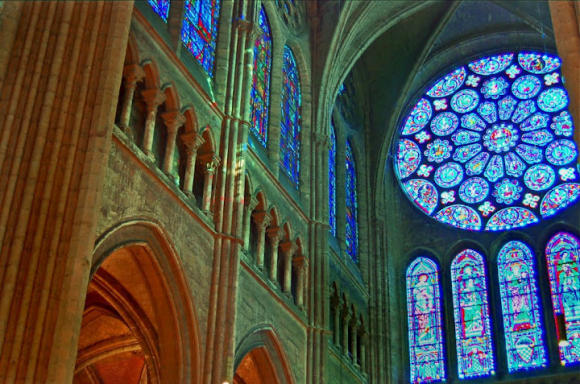
Notre-Dame de Chartres is so rich in sculpture, stained glass and architectural details that having a guided tour or an audio-guide or book to point out some of the most significant ones can go a long way in helping you understand the cathedral’s hows and whys.

